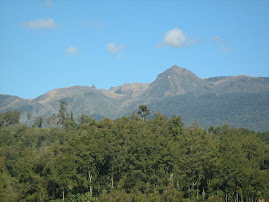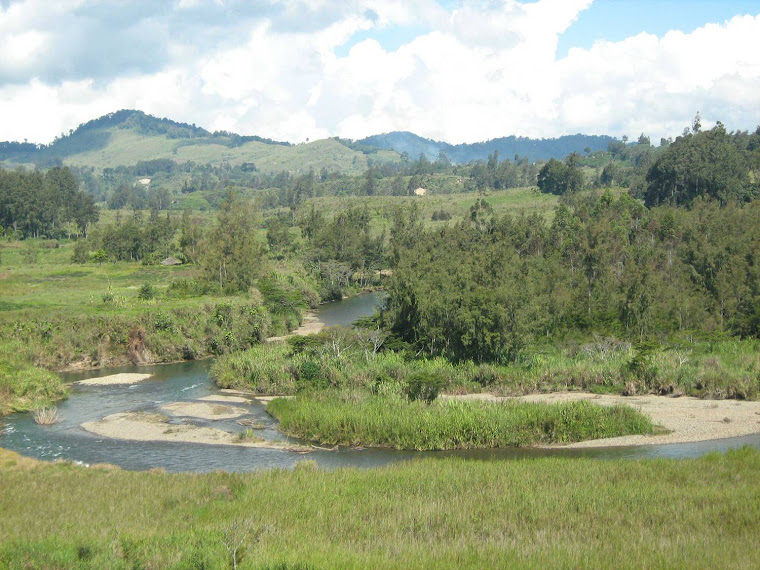This extra commentary was published by Sunday Chronicle on Sunday August 23, 2009.
..................
By Mathew Yakai
PAPUA New Guinea is truly a land of a thousand tribes and cultures.
Nowhere else in the world will you find over 800 different languages and rich and diverse cultures and traditions.
This cultural varieties and richness is showcased every year in cultural shows and festivals which gather together thousands of tribes’ men and women in their traditional finest.
These are sights and sounds that will stay in your memory forever.
In terms of language, two provinces in PNG stand unique. Enga Province has only one language while Madang has the highest (more then 30) different languages. Others fall in between.
So when you want to experience cultural diversity in few days with little money then Madang is definitely the destination.
But no other days are as perfect as the days when the infamous Madang Festival Show is on.
That is why both international and domestic tourists must mark on their calendar and itinerary the famous Madang Festival Show from September 16 to 19, only three weeks from today.
The Madang Festival Show was officially launched on Friday August 14 at Madang Resort with the ribbon cutting performed by Pete Celso, Executive Vice President and Managing Director of RD Tuna, Madang.
The ceremony was witnessed by Chairman of Madang Provincial Events Council Stotick Kamya and Mayor of Madang Town, Michael Kamo during the Events Council Fundraising Committee Corporate Dinner.
Major business houses in Madang were present during the ceremony.
Madang Festival Show was formerly known as Maborasa Show in the early 1980s.
MABORASA stands for Madang, Bogia, Ramu and Saidor. But people along the North Coast and Karkar Island complained that Maborasa is not representative of Madang when Sumkar District was not included.
Under the new Provincial Events Council in 1991, the current Madang Festival Show was adopted and held its first ever Show.
But for 18 years after 1991 till 2008, Madang Festival Show was put to rest due to various problems faced by the Council.
It was revived again last year, 2008. This year, the Show will be held from Sep 16 to 19, coinciding with the 34th Anniversary of PNG’s Independence.
Since the long break till last year, the adamant working Provincial Events Council under the strong chairmanship of Stotick Kamya, this years Event will be a bigger one.
The Festival will be a breath taking and refreshing for the youths who have not seen their proud and unique cultures which started only last year after a long recess.
During his opening remark, Mr. Stotick Kamya told the business houses in Madang who attended the Corporate Dinner that Madang Festival Show was started last year after a long recess and this year will be the second time where the Events Council is planning for a bigger Event.
Mr. Kamya said the Festival will see events like traditional dances, canoe race, game fishing, greasy pole, pillow fighting, coconut scraping, coconut husking, tug of war and many more.
The soldiers from Moem Barracks will be invited to add more flavor to the event on Sep 16 when PNG turns 34.
He said the Events Council planned to invite international groups from New Zealand, Australia and China but this could not eventuate due to financial and logistic problems. But these will be considered in the future.
“We will also have the international night where international community will put their own dressings and costumes to show their country of origin,” Mr. Kamya said.
He also thanked the business houses for attending the Corporate Dinner which is part of the Events Council’s fundraising drive to meet the cost of the Festival.
Mr. Kamya thanked business houses, organizations and individuals in Madang and PNG for their past support and looking forward to more in this year’s Festival.
Guest Speaker during the Corporate Dinner, Pete Celso, Executive Vice President and Managing Director of RD Tuna told the gathering that his company has supported the Event since it arrived in 1996 and this year will receive the same treatment.
“We have started by K10,000. and sponsored a table,” Mr. Celso said.
In his speech, Mr. Celso reiterated that the people of PNG must focus on positive things and attitudes, instead of negative things to see tangible and positive changes in the country.
“Having lived in PNG for 15 years, I have seen people focusing on negative things, but there are lots of positive things to be seen and accepted,” he said.
Mr. Celso reiterated on the ethic and logic of working smart, hard, be ambitious and make progress in individual lives, family, communities and the country as a whole.
“No one dies for the Vision but for the Cost. You must have the right Vision and fight for the right Cost,” he concluded.
Mr. Celso who has lived in PNG to understand the development trend said that Madang Show is important to bring together traditional tribes to see commonalities in their cultures to live harmoniously in diversity.
He said Madang alone has the largest language in PNG and this can give money for value to potential tourists who plan for Madang Show.
The gate fee is only K5. for adults and K3. for students and children. From this, the show goers will learn a lot from the Show including varieties of traditional dances and events like greasy pole, pillow fighting, canoe race etc.
The corporate houses in Madang will also showcase their products, ranging from mine explorations like multi billion Kina Ramu Nickel Project to Ramu Agro Industries in agriculture and others.
But remember that with around 30 different languages in Madang alone, the upcoming Madang Festival Show will be overwhelmed with different cultural flavors because the legacies of WWII and outside influence had minor impact in this ingrained Melanesian culture.
Due to changes by outside contact over the years, cultural loss has been great, according to some reports, but isolation of many groups has caused that rate of change to be diversely uneven.
Because of the environmental diversity, Madang also has a very diverse culture as well with tall lithe coastal people from Karkar Island, short nuggety highlands men from Simbai and river people from Ramu.
Many Madang area costumes include bamboo frames decorated with the very common cockatoo and parrot feathers as Birds of Paradise are relatively uncommon.
The Ramu people are prolific carvers and the lower Ramu has cultural links with the villages of the artistically diverse Sepik River region.
It is interesting to note that the resurgence of Madang Festival Show has seen many people donning the fantastic traditional dress, feathers and paints of their ancestors.
Foods eaten include those grown in fertile coastal gardens, shellfish and fish, fruit, green vegetables, bananas, taro, sweet potatoe and yams especially in its lower reaches. The mountain people have very good gardens with excellent produce.
Linguistically, Madang province is typified by a large number of very small language groups, many with fewer than 1,000 people.
Austronesian sailors settled on this coast some 5 to 6,000 years ago and the languages of these intrepid but largely unknown sailors are found along the coast of the province.
Lukep, Gedaged, Manam and Bilbil languages are examples of this. Inland, the Katiati, Hinihon and Saki languages are examples of Papuan (non-Austronesian) languages found in the region.
The Ramu river language includes Gamei, Giri, Tangu, Romkun and Igana and the Rai Coast language include Somau Garia and Usino.
The volcanic island of Karkar is unusual in that it is shared by the Papuan language Waskia and the Austronesian language Takia.
Given the language diversity and cultural difference, the upcoming Madang Festival Show is a must see for those who know very little about Beautiful Madang.
Having lived in Changchun city, the capital of Jilin Province in China for two years was memorable, but there is no such place as an idyllic Pacific coastal town as Madang.
Kalibobo Light House, one of Madang’s infamous icon built during the WWII stands tall today attracting tourists, while the blue sky over Madang is flocked with the ancestral inhabitants, the flying foxes.
Walking from Kalibobo Light House towards Smugglers Inn along the stressing lawn, with coconut leaves above swing to the strength of the ocean breeze while the sea, just a stone throw away stressing as far as the eye can see brings freshness to mind to accept the nature in harmony.
Changchun City known for its car factory has vehicles of all shapes and sizes occupying the streets, while the pedestrians is so huge that one shoves through daily.
And the factory chimneys swirl smokes into the blue sky making invisible the sunset and sunrise.
But in Madang, the sun rise is as perfect as sun set depicting the perfect harmony of Gods blessing over humanity. In Madang, we say thank you to God for the visible sun.
While the daily life in Changchun is always in rush, Madang is so harmonious and slow in line with its economic statutes, where the people live in perfect peace and harmony with the nature and culture intact.
And Madang is not an ordinary province in Papua New Guinea. It is a popular tourist destination in the country, both for domestic and international tourists.
Welcome to Madang Festival Show from Sep 16th to 19.
Note: This commentary is inline with Sunday Chronicles mission for developmental journalism in encouraging positive journalism. Sunday Chronicle will carry more commentaries in the following Sundays to encourage tourism during Madang Festival Show. For comments, contact the writer on m_yakai@hotmail.com or SMS 71489901
American movie include Fijians as cast and crew
6 years ago









No comments:
Post a Comment